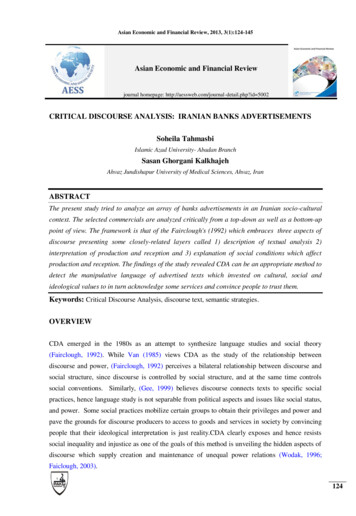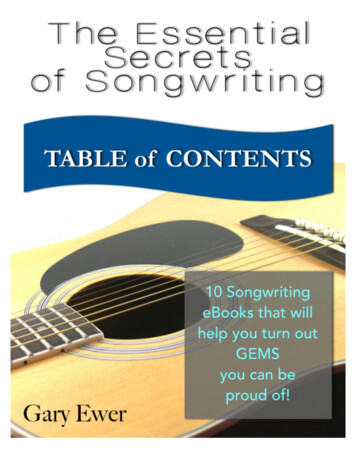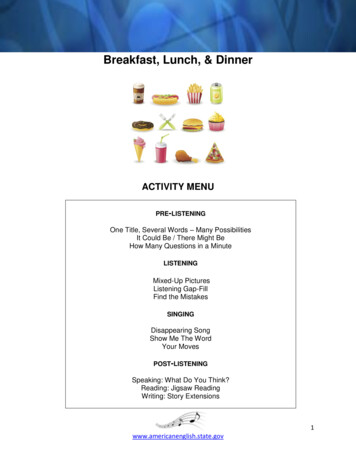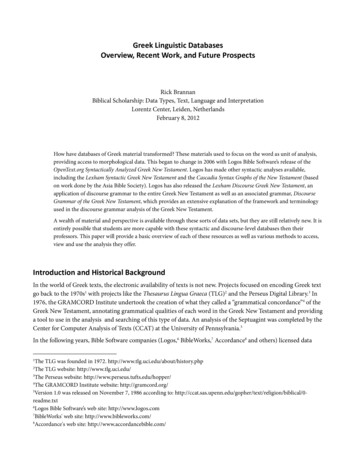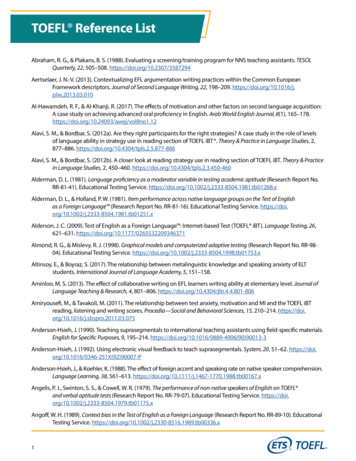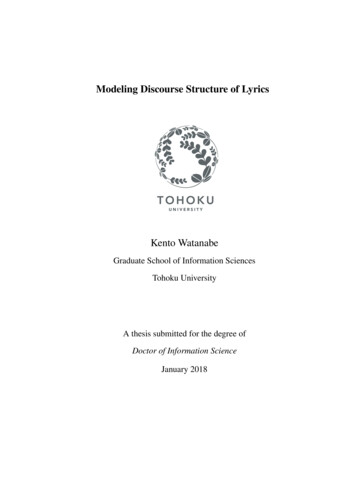
Transcription
Modeling Discourse Structure of LyricsKento WatanabeGraduate School of Information SciencesTohoku UniversityA thesis submitted for the degree ofDoctor of Information ScienceJanuary 2018
AcknowledgementsI would like to thank Professor Kentaro Inui whose comments and suggestions were of inestimable value for my whole study. He is the chiefexaminer for my thesis and has made his support available in a number ofways. I also would like to express my gratitude to Professor Akinori Itohand Professor Satoshi Shioiri. They are the sub examiner of my thesis.They gave me a lot of valuable comments for improving the quality of mystudy.I am also thank to Professor Naoaki Okazaki at Tokyo Institute of Technology. He gives me constructive comments and warm encouragement.I am particularly grateful for the assistance given by Assistant ProfessorYuichiroh Matsubayashi. His support and encouragement were invaluable.I am deeply grateful to Dr. Masataka Goto, Dr. Satoru Fukayama, and Dr.Tomoyasu Nakano at National Institute of Advanced Industrial Scienceand Technology (AIST) in Japan. When I had been a visiting researcherat AIST for six times from 2014 to 2017, they gave me a lot of usefuland insightful comments. I believe that a lot of achievements in this thesiswould not have been possible if I couldn t collaborate with them.I gratefully appreciate the financial support of Japan Society of PromotionSciences Fellowship that made it possible to complete my thesis.My colleagues gives me constructive comments and warm encouragement.Especially, I would like to thank Yamaki-san, Narita-san, Sugawara-san,Inoue-san, and Aizawas-san the secretary of our lab. I believe that our labwould go bankrupt if they were not the secretary of our lab.I would like to express the deepest gratitude to Hatsune Miku. I couldalways try hard because of her. Without her encouragement, this thesiswould not have materialized.
Finally, I would like to express my gratitude to my family for their kindsupport and warm encouragements.
AbstractLyrics are an important element in popular music that conveys stories andexpresses emotion. Unlike prose text, writing lyric requires consideration of music-specific properties such as the structure of melody notes andrests, rhythms, and repetitions. Especially, lyrics also have paragraphs andsentences corresponding to discourse segments. Thus, the goal of this thesis is modeling the discourse nature of lyrics to understand the structure oflyrics.Once a reasonably sophisticated computational model of discourse structure of lyrics is obtained, the model will provide us a better understandingof the nature and structure of lyrics, which will then allow us to considerbuilding computer systems which can enhance the creativity of humanlyrics writers. In spite of its importance, however, no prior study has everaddressed the issue of modeling this discourse-oriented nature of lyrics.This is the first study that takes a data-driven approach to exploring thediscourse structure of lyrics in relation to various lyrics-specific properties. In particular, we propose several computational models of discoursestructure from three viewpoints. The first viewpoint is modeling discourse segments in lyrics. Thisthesis conduct the first large-scale corpus study on discourse segments in lyrics, where we examine our primary hypothesis that discourse segmentations in lyrics strongly correlate with repeated patterns. To test our hypothesis that discourse segmentations in lyricsstrongly correlate with repeated patterns, we conduct the first largescale corpus study. Then, we propose the task to automatically identify segment boundaries in lyrics and train a logistic regression modelfor the task with the repeated pattern and textual features. The results
of our experiments illustrate the significance of capturing repeatedpatterns in predicting the boundaries of discourse segments in lyrics. The second viewpoint is modeling the two common discourse-relatednotions: storylines and themes. We assume that a storyline is a chainof transitions over topics of segments and a song has at least one entire theme. We then hypothesize that transitions over topics can becaptured by a probabilistic topic model which incorporates a distribution over transitions of latent topics and that such a distributionof topic transitions is affected by the theme of lyrics. To test thosehypotheses, we conduct experiments on the word and segment orderprediction tasks. The experimental results show that our probabilistictopic model capture storylines effectively and considering the notionof theme contributes to the modeling of storylines. The third viewpoint is modeling relationship between melodies anddiscourse segments. To investigate this relationship, we created acollection of 1,000 lyrics-melody pairs augmented with mora-notealignments and word/sentence/paragraph boundaries, which is, toour knowledge, the biggest collection of precisely aligned lyricsmelody parallel data provided in this field. We report on our quantitative analysis of the correlation between word/sentence/segmentboundaries in lyrics and rests in melodies. Our experimental resultsshow strong tendency that the boundaries of larger segments tend tocoincide more with longer rests.In addition to the above studies, this thesis presents a novel, purely datadriven model for lyrics generation by conditioning an language model witha featurized input constraints such as topics, mora-counts, and melodies.Our experimental results show that combining a limited-scale collectionof lyrics-melody alignment data and a far larger collection of lyrics-alonedata for training the model boosts the model’s capability of generating afluent lyrics and fitting it to the input melody.We also propose a novel lyric-writing support system using our lyrics language model. Previous systems for lyric writing can fully automatically
only generate a single line of lyrics that satisfies given constraints on accent and syllable (or mora) patterns or an entire lyric. In contrast to suchsystems, our system allows users to create and revise their study incrementally in a trial-and-error manner. Through fine-grained interactionswith the system, the user can create the specifications of the discoursestructure, mora-counts, and most importantly, storylines (i.e., the transition over topics of segments).This thesis is a basic research of modeling discourse structure of lyricsand a practical research for computer-assisted or fully-automated creationof lyrics.
ContentsContentsviList of FiguresxNomenclaturexi1Introduction1.1 Research Issues . . . . . . . . . . . . . . . . . . . . . . . . . . . . .1.2 Contributions . . . . . . . . . . . . . . . . . . . . . . . . . . . . . .1.3 Thesis Overview . . . . . . . . . . . . . . . . . . . . . . . . . . . .13452Natural Language Processing of Lyrics2.1 Overview of Modeling Lyrics-specific Property . . . . . . .2.1.1 Modeling Styles of Lyrics . . . . . . . . . . . . . .2.1.2 Modeling Relationship between Melodies and Lyrics2.1.3 Modeling Semantic Structure of Lyrics . . . . . . .2.1.4 Modeling Discourse Structure of Lyrics . . . . . . .2.2 Overview of Application Tasks Using Lyrics Processing . . .2.2.1 Automatic Lyrics Generation . . . . . . . . . . . . .2.2.2 Writing Support Interface . . . . . . . . . . . . . .7778888893.Modeling Discourse Segments Using Repeated Patterns3.1 Overview of Text Segmentation . . . . . . . . . . . . . . . . . . . .3.2 Statistics of Repeated Patterns and Segment Boundaries . . . . . . . .3.2.1 The Basic Distribution of Lyrics . . . . . . . . . . . . . . . .3.2.2 Correlation between Repeated Patterns and Segment Boundariesvi1010121213
CONTENTS3.33.43.545Computational Modeling of Segment Patterns in Lyrics3.3.1 Repeated Patterns . . . . . . . . . . . . . . . .3.3.2 Textual Expressions . . . . . . . . . . . . . .Experiment . . . . . . . . . . . . . . . . . . . . . . .3.4.1 Performance Evaluation Metrics . . . . . . . .3.4.2 Contributions of Different Features . . . . . .3.4.3 Error Analysis . . . . . . . . . . . . . . . . .Conclusion . . . . . . . . . . . . . . . . . . . . . . .Modeling Storylines4.1 Overview of Topic Sequence Model . . . . . . . . . . . . . . . . .4.2 Model Construction . . . . . . . . . . . . . . . . . . . . . . . . . .4.2.1 Preliminaries . . . . . . . . . . . . . . . . . . . . . . . . .4.2.2 Base Model 1: Content Model . . . . . . . . . . . . . . . .4.2.3 Base Model 2: Mixture of Segment Model . . . . . . . . .4.2.4 Proposed Model 1: Mixture of Unigram and Content Model4.2.5 Proposed Model 2: Mixture of Content Model . . . . . . .4.3 Experiments . . . . . . . . . . . . . . . . . . . . . . . . . . . . . .4.3.1 Word Prediction Task . . . . . . . . . . . . . . . . . . . . .4.3.2 Segment Order Prediction Task . . . . . . . . . . . . . . .4.3.3 Analysis of Trained Topic Transitions . . . . . . . . . . . .4.4 Conclusion . . . . . . . . . . . . . . . . . . . . . . . . . . . . . .Modeling Relationship between Melody and Lyrics5.1 Melody-Lyric Alignment Data . . . . . . . . .5.2 Correlations between Melody and Lyrics . . . .5.2.1 Melody and Intonation . . . . . . . . .5.2.2 Melody and Line/Segment Boundaries .5.3 Melody-Conditioned Generation of Lyrics . . .5.3.1 Model construction . . . . . . . . . . .5.3.2 Context melody vector . . . . . . . . .5.3.3 Training Strategies . . . . . . . . . . .5.3.3.1 Pretraining . . . . . . . . . 3444647474851525353
CONTENTS5.45.55.65.3.3.2 Learning with Pseudo-Melody . . .Quantitative Evaluation . . . . . . . . . . . . . . . . .5.4.1 Experimental Setup . . . . . . . . . . . . . . .5.4.1.1 Hyperparameters . . . . . . . . . . .5.4.2 Evaluation Metrics . . . . . . . . . . . . . . .5.4.2.1 Perplexity . . . . . . . . . . . . . .5.4.2.2 Accuracy of Boundary Replication .5.4.3 Comparison of Pretraining Settings . . . . . .5.4.4 Effect of Melody-conditioned RNNLM . . . .5.4.5 Effect of Predicting Mora-Counts . . . . . . .5.4.6 Analysis of Input Melody and Generated LyricsQualitative Evaluation . . . . . . . . . . . . . . . . .5.5.1 Experimental Setup . . . . . . . . . . . . . . .5.5.2 Results . . . . . . . . . . . . . . . . . . . . .Conclusion . . . . . . . . . . . . . . . . . . . . . . .5354555555555556565859606061626Interactive Support System for Writing Lyrics6.1 Overview of Writing Support . . . . . . . . . . . . . . . . . . . . . .6.2 LyriSys: An Interactive Writing Interface based on Discourse Structure6.2.1 Step 1): Set the Musical Structure . . . . . . . . . . . . . . .6.2.2 Step 2): Set/estimate the Story . . . . . . . . . . . . . . . . .6.2.3 Step 3): Generate/edit the Candidate Lines of Lyrics . . . . .6.3 Implementation . . . . . . . . . . . . . . . . . . . . . . . . . . . . .6.4 User Feedback . . . . . . . . . . . . . . . . . . . . . . . . . . . . .6.4.1 Experimental Setup . . . . . . . . . . . . . . . . . . . . . . .6.4.2 Results . . . . . . . . . . . . . . . . . . . . . . . . . . . . .6.5 Conclusion . . . . . . . . . . . . . . . . . . . . . . . . . . . . . . .64646667686969707172727Conclusions74A Proof of Theorem in Chapter 4.2A.1 Equation for Mixture of Unigram and Content Model Inference . . . .A.2 Equation for Mixture of Content Model Inference . . . . . . . . . . .viii777778
CONTENTSReferences81List of Publications88ix
List of Figures1.11.2Examples of awkward and natural lyrics. . . . . . . . . . . . . . . . .An example of lyrics with a storyline and repeated patterns. . . . . . .3.13.23.33.43.53.6An example of lyrics and corresponding self-similarity matrix.Negative example against pattern (1). . . . . . . . . . . . . . .Repeated pattern features: RPF1, RPF2, and RPF3. . . . . . .Textual features: TF1 and TF2. . . . . . . . . . . . . . . . . .Examples of false positives. . . . . . . . . . . . . . . . . . . .Examples of false negatives. . . . . . . . . . . . . . . . . . .4.14.24.3The notion of storylines and themes in lyrics. . . . . . . . . . . . . .Plate notation of base models and the proposed combination models. .Log-likelihood on English test data under different segment topic settings. . . . . . . . . . . . . . . . . . . . . . . . . . . . . . . . . . . .Log-likelihood on Japanese test data under different segment topic settings. . . . . . . . . . . . . . . . . . . . . . . . . . . . . . . . . . . .Average Kendall’s τ for English lyrics against the number of randompermutations. . . . . . . . . . . . . . . . . . . . . . . . . . . . . . .Average Kendall’s τ for Japanese lyrics against the number of randompermutations. . . . . . . . . . . . . . . . . . . . . . . . . . . . . . .Examples of English MCM transitions between topics for each theme.Examples of Japanese MCM transitions between topics for each theme.4.44.54.64.74.85.1.Automatic melody-lyric alignment using the Needleman-Wunsch algorithm. . . . . . . . . . . . . . . . . . . . . . . . . . . . . . . . . .x23111417172122252734343636394244
LIST OF FIGURES5.25.35.45.5Melody and intonation. . . . . . . . . . . . . . . . . . . . . . . . . .Relationship between pit changes and intonation changes. . . . . . . .Example of boundaries appearing immediately after a rest. . . . . . .Distribution of the number of boundaries in the melody-lyric alignmentdata. . . . . . . . . . . . . . . . . . . . . . . . . . . . . . . . . . . .5.6 Melody-conditioned RNNLM. . . . . . . . . . . . . . . . . . . . . .5.7 Distribution of the number of boundaries in the pseudo data. . . . . .5.8 Distribution of the number of boundaries in the test data and lyricsgenerated by the Pseudo-melody model. . . . . . . . . . . . . . . . .5.9 Distribution of the mora count of the generated lines/segments. . . . .5.10 An example Japanese lyric generated by the Pseudo-melody model. .4646476.16.26.36.465666873An example LyriSys screen. . . . . . . . . . . . . . . . . . . .The edit panel in LyriSys; the user can set the musical structure.The setting panel in LyriSys. . . . . . . . . . . . . . . . . . . .Example of Japanese lyrics when the user uses LyriSys. . . . . .xi.495054596063
Chapter 1IntroductionLyrics are an important element of popular music. They provide an effective means toexpress the message and emotion of music. Unlike prose text, lyrics have their own peculiar properties, such as the structure of melody notes and rests, rhythms, repetitions,etc. [Austin et al., 2010; Ueda, 2010]. A simple example is the correlation betweenword boundaries in lyrics and rests in melody. As in Figure 1.1, one feels it awkwardif a single word spans beyond a (long) melody rest. A lyrics writer needs to considersuch constraints in content and lexical selection, which imposes extra cognitive loads.The writer may also consider using rhymes, refrains or repetitions to color the entirestory rhetorically as in the example lyrics shown in Figure 1.2, where rhymes can beseen at night, light and tight in Segment 7. Writing lyrics is thus a complex task.These properties of lyrics have been motivating a range of research for computerbased modeling of lyrics [Greene et al., 2010; Mayer et al., 2008; Nichols et al.,2009; Reddy and Knight, 2011] and computer-assisted or fully-automated creation oflyrics [Abe and Ito, 2012; Barbieri et al., 2012; Ghazvininejad et al., 2016; Oliveiraet al., 2007; Potash et al., 2015; Ramakrishnan A et al., 2009]. In particular, building a computational model of lyrics is an important research goal. Once a reasonablysophisticated computational model of lyrics is obtained, the model will provide us abetter understanding of the nature and structure of lyrics, which will then allow us toconsider building computer systems which can enhance the creativity of human lyricswriters. In reality, however, while an increasing number of papers have been publishedfor demonstrating computer systems that automatically generate lyrics or assist humanlyricists [A and Devi, 2010; Abe and Ito, 2012; Barbieri et al., 2012; Ghazvininejad1
Flute, @@ , - )2 ) ) ) ) ) ) ) ) ) ) ! - ) ) #) ) (!Example of awkward lyrics., , - )2 ) ) ) ) ) ) ) ) ) ) , ) ) ) ) (!ma-da shi- rana- ia- shi・ ta e yu-ku)))))!))))) (to)まだ知ら明日へ) #)行くない)) (!,)2 ) )(know) @, , - -(yet)(not)(tomorrow)(go))) ) to)an unknown! - ) ) #)) ) (!)))), @, - )2) ) (Proceedtomorrow))))))(!)))))),,Examplelyrics. , - )2of) natural))), , - ))2) )) )) ) )! . ) )#) )) )) )) -, ) )) )) )) )) ((!de 7 a- ru- i -tako-no mi-chi , - hi-to-ri7一人7)))))!)歩いた) ! )) #)) (road)で道 (!)) )) )) - この),)2)) ) (FUNC)! , ) (alone))#))(walked)(this)') - )7alone. This road)- )7 ) ) , - ) ) ) ))(I walked))))(!))))),,2) ardandnaturallyrics.ThetranslatedEnglishlyricsare - ) ) ) )(FUNC)7))))))!))()given in, mthe RWC.)7 ! ) ) No.20) Database! ) )7 #)(RWC-MDB-P-2001#) ) et al.,)! 2002].7 ) ) - )7 ) ! #) ) ) ) - )Music[Goto)))))))) , ) ) ) ) ) - ) ) ! #) ) ) ) - ) ) ! ) ) ) '7et al.,Oliveiraet al., 2007; Potashresearchfor7) et( al., 2015; Wu) et al.,7 )2013], 2016;! )7 ) ) rpropertiesisstilllimited[Greeneetal.,2010;7 ! )2009;#)and)Knight,)))))) ) ) ! - ) ! ) ) ) )!7 . ) )Mayeretal.,2008;Nicholsetal.,Reddy One(crucial ,issue)we)miss(in! those studies- is )modeling))!!#))the2011].)) )) as dis'nature )of lyrics7 !)! ) ) #)to )prose) text,) !a )piece) )of)lyrics#) typically#) ) ) ) - )))!)))course.) Similarcomprisesparagraphsand)7 7sentences corresponding to discourse segments; namely, lyrics of popular music typ ) ! )the)verse,! )7 ) ) ))))et )al.,2005]and suchically hasbridge, andchorussegments[Mahedero)!)!!)))(),7 may comprise more fine-grained segments as in Figure 1.2. Each segmentsegments ( part of,the )entire) story( ! and the segmentsprovidesare organized(orsequentiallyor!#))))))))'dered) so as to constitute a coherent structure- as a7 whole. Moreover, chorus segmentsappear repeatedly (e.g., in Figure 1.2, segments 5, 8 and 9 are identical to segment 1),whichis not typically observed in prose text. In spite of its importance, however, no prior study has ever addressed the issue of modeling this discourse-oriented nature oflyrics. Motivated by this background, in this thesis, we report on our novel study forbuilding several computational models of the discourse nature of lyrics. l45Fl492
Segment 1 (verse)If you go back in timeTo a place in your mind, like a clear viewI gave you my word that I would never leave youSegment 2 (verse)Segment 6 (verse) “introduces the story”Sometimes I just forgetSay things I might regret but believe meIt breaks my heart to see you cryingFrom the night we first metYour smile's been the meaning of my lifeWith just a glance I knew you were mineSegment 3 (bridge)Segment 7 (bridge) “describes a past event”I don't want to lose yo babyI could never make it aloneAfter all these years, oh maybeA bit of misunderstanding has sneaked into our livesI was all alone in the nightAnd it was you who gave me the lightLet me hold you, oh so tightDon't let a bit of misunderstanding come in between usSegment 4 (chorus)Segment 8 (chorus) “express an emotion”Don't you never ever say goodbyeDon't tell me that's the thing that's on your mindWe both know we are made for each otherSo don't leave me behindDon't you never ever say goodbyeDon't tell me that's the thing that's on your mindWe both know we are made for each otherSo don't leave me behindSegment 5 (chorus)Segment 9 (chorus) “express an emotion”So don't you ever say goodbyeDon't tell me that's the thing that's on your mindSo until I find a way to rid this painDon't say goodbyeSo don't you ever say goodbyeDon't tell me that's the thing that's on your mindSo until I find a way to rid this painDon't say goodbyeFigure 1.2: An example of lyrics with a storyline and repeated patterns (title: Don’tSay Good bye (RWC-MDB-P-2001 No.90 from RWC Music Database [Goto et al.,2002])).1.1Research IssuesIn this thesis, we address following four research issues.Does the discourse segments in lyrics strongly correlate with repeating patterns?Phrases of lyrics often appear repeatedly, and this repeated pattern may be correlated with discourse segments. For example, if a sequence of lines in lyrics has arepetition, such as abcdefabc (each letter represents a line, with repeated lettersbeing repeated lines), we expect the boundaries of the discourse segments tendto agree with the boundaries of the repeated parts as in abc def abc , where “ ”indicates a boundary. However, no prior study has ever verified this correlation.What is the most suitable way to model storylines in lyrics? Each discourse segmentin lyrics provides part of the entire story and the segments are organized (or sequentially ordered) so as to constitute a coherent structure as a whole. In Figure 1.2, for example, Segment 6 introduces the story, Segment 7 retrospects apast event, and Segment 8 and 9 express an emotion which arises from the retrospection. However, no study has ever addressed the issue of modeling storylines3
in lyrics.Does the discourse segments in lyrics strongly correlate with melody? Several correlations between melody and lyrics are expected. For example, words, sentences and segments rarely span beyond a long melody rest and the boundaries oflarger components (i.e., discourse segments) tend to coincide more with longerrests. This direction of research, however, has never been promoted partly because it requires a large training dataset consisting of aligned pairs of lyrics andmelody but so far no such data has been available for research. We refer to thedata as a melody-lyric alignment data.Are discourse structure models efficient in automatic lyrics generation task? In addition to modeling the discourse structure, we are interested in the effectivenessof discourse model for demonstrating computer systems that automatically generate lyrics or assist human lyricists.1.2ContributionsThis thesis makes following contributions.Modeling and investigating discourse segments in lyrics. To examine our primaryhypothesis that discourse segments in lyrics strongly correlate with repeatedpatterns, we consider the task of computationally predicting the boundaries ofdiscourse segments in lyrics under the assumption that a better prediction modelwould allow us to better understand the nature of the discourse structure of lyrics.This is the first study that takes a data-driven approach to exploring the discoursestructure of lyrics in relation to repeated patterns.Modeling and investigating storylines in lyrics. To capture the two common discourserelated notions: storylines and themes, we hypothesize that transitions over topics of lyric segments can be captured by a probabilistic topic model which incorporates a distribution over transitions of latent topics and that such a distributionof topic transitions is affected by the theme of lyrics.Melody-lyric alignment data. To create a large collection of lyrics-melody alignment data, we propose a methodology for creating melody-lyrics alignment data4
by leveraging lyrics and their corresponding musical score data on the web. Toour knowledge, this dataset is the biggest collection of precisely aligned lyricsmelody parallel data provided in this field. While this thesis reports on our experiments with Japanese song data, presumably the approach will work for otherlanguages as well.Modeling and investigating relationships between lyrics and melodies. We deeplyanalyze the correlation between melody and lyrics, and evaluate proposed modelquantitatively. This is the first study that has ever provided such strong empiricalevidence to the hypotheses about the correlations between lyrics segments andmelody rests. In addition to this analysis, we propose a novel, purely lyrics generation model that output lyrics for an entire input melody. We extend a commonRecurrent Neural Network Language Model (RNNLM) [Mikolov et al., 2010] sothat its output words can be conditioned with a featurized input melody. To ourknowledge, these are the first language models that jointly learn the consistencybetween word, line, and segment boundaries and melodies.Novel interactive support system for writing lyrics. As mentioned in the beginningof this chapter, for writers of lyrics, considering various lyrics-specific propertiessimultaneously is not easy. This is where appropriate human-computer interaction system can reduce human loads. Therefore, this thesis provides an overviewof the design of the system and its user interface and describes how the writingprocess is guided by our probabilistic discourse structure model. Our systemcan assist a writer in incrementally taking the above factors into account throughan interactive interface by generating candidate pieces of lyrics that satisfy thespecifications provided by the writer. The capability of automatically generating lyrics and allowing the user to create lyrics incrementally in a trial-and-errormanner can be useful for both novices and experts.1.3Thesis OverviewThe rest of this thesis is structured as follows.Chapter 2: Natural Language Processing of Lyrics. In this chapter, we give an overview5
of natural language processing of lyrics. We show that most of the previous studies focus on modeling lyric-specific properties except discourse structure.Chapter 3: Modeling Discourse Segments Using Repeated Patterns. This chapterpresents the first quantitative analysis of the distribution of repeated lines andsegments in lyrics and suggests cues that could help to identify the segmentboundaries. Then, we describes our computational model, which predicts theboundaries of discourse segments in lyrics using repeated patterns.Chapter 4: Modeling Storylines. To investigate the effects of capturing topic transitions, we describe a probabilistic topic model which incorporates a distributionover transitions of latent topics. Moreover, to verify that both theme and topictransition are useful for modeling the storyline, we propose two extended combination models to handle theme and storyline simultaneously.Chapter 5: Modeling Relationship between Melody and Lyrics. We first propose anovel method for creating a lyrics-melody aligned parallel dataset. We thenquantitatively analyze the correlations between lyrics segment boundaries andmelody rests. Finally, we build a lyrics language model capable of generatingfluent lyrics whose segment boundaries fit a given input melody.Chapter 6: Interactive Support System for Writing Lyrics. We describe the functions of the proposed system and then describe the probabilistic generative modelwhich the system employs to generate candidate lyrics. Moreover, to investigatethe capabilities, limitations, and potential of our interaction design, we askedhuman-users to use our system and collected preliminary user feedback.Chapter 7: Conclusions. We summarize our discussion, and present our future direction.6
Chapter 2Natural Language Processing of LyricsThis chapter briefly summarizes the related work on the natural language processingfor lyrics. We first, describe the overview of modeling lyrics-specific properties suchas rhyme, melody, and so on. We then, introduce overview of application tasks usinglyrics processing.2.1Overview of Modeling Lyrics-specific PropertyThese prior studies share the motivation of modeling lyric-specific properties withour study. However, no previous study has ever considered capturing the discourseoriented nature of lyrics whereas our study aims at modeling (1) discourse segments,(2) storylines, and (3) relationship between melody and discourse.2.1.1 Modeling Styles of LyricsSeveral studies for capturing lyric-specific styles have been reported, where a broadrange of music elements including meter, rhythm, rhyme, stressed/unstressed syllables,and accent are studied. Mayer et al. [2008] trained a support vector machine to classifymusic genres using only textual features such as rhyme and part-of-speech patterns.Greene et al. [2010] employed a finite-state transducer to assign syllable-stress patternto all words in each line. Reddy and Knight [2011] developed a language-independentrhyme model based on a Markov process that finds rhyme schemes.7
2.1.2 Modeling Relationship between Melodies and LyricsOliveira et al. [2007] analyze correlations among melodies, beats, and syllables using42 Portuguese songs. Nichols et al. [2009] identified several patterns in the relationshipbetween the lyrics and melody in popular music by measuring the correlation betweentextual salience and musical salience.2.1.3 Modeling Semantic Structure of LyricsSeveral studies aim at modeling semantic structure of lyrics. Kleedorfer et al. [2008]classified lyrics according to topical clusters calculated using nonnegative matrix factorization [Xu et al., 2003]. Sasaki et al. [2014] visualized lyric clusters calculatedusing Latent Dirichlet Allocation (LDA) [Blei et al., 2003].2.1.4 Modeling Discourse Structure of LyricsPrevious computational work into lyrics discourse segmentation has focused on identifying the segment labels of lyrics that are already segmented. For example, the structure of lyrics can be represented using labels A–B–C–A–B in which each letter refersto a group of lines; e.g., A might represent a chorus that appears twice. Barate et al.[2013] proposed a rule-based method to estimating such structure labels of segmentedlyrics.2.2Overview of Appli
of lyrics-melody alignment data and a far larger collection of lyrics-alone data for training the model boosts the model's capability of generating a fluent lyrics and fitting it to the input melody. We also propose a novel lyric-writing support system using our lyrics lan-guage model. Previous systems for lyric writing can fully automatically
